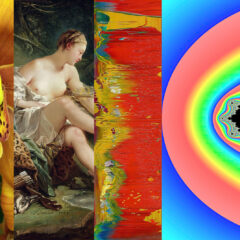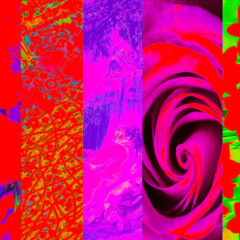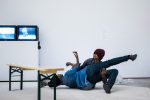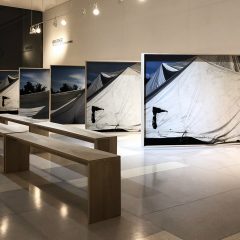“I have some stories for you,” said Mari Shaw as she looked down on me from her spot on the ramp at the Institute of Contemporary Art. It was Sept. 6, the opening of the museum’s fall shows, and the curators were doing their walk-through of the various exhibits before the reception. The talk started downstairs and everyone had just moved up the ramp and into the second floor Project Space. I was a lone straggler when Shaw greeted me with her conspiratorial conversation opener.
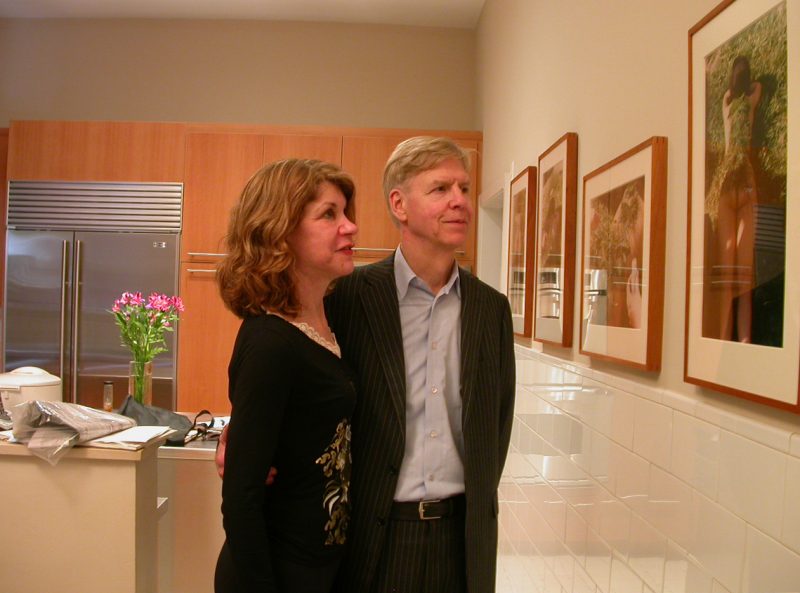
Mari and Peter Shaw in their kitchen in Center City, looking at photos of an Ana Mendieta performance.
Mari Shaw’s stories — I got the bare bones of them right there with the promise of more details to come — were good ones involving action, deal brokering, and forward-momentum. I was amazed to hear what she told me: That internationally renowned artist and photographer Candida Hofer was coming to Philadelphia in a week to do a photo shoot; and that a new international residency program at University of the Arts had been set up with Portuguese artist Vasco Araujo, the first artist in residence. How was it that all this was happening I asked. Who is bringing these artists to Philadelphia? Shaw said, “I am.”
Shaw and her husband, Peter L. Shaw, collect art and live with a large contemporary collection in a Frank Furness-designed row house on Spruce Street in Center City. The Shaw collection includes work by big names and some less well known, international superstar artists and Philadelphia artists. Walking through the big house you’ll see major works by Donald Judd, Robert Ryman, Richard Serra, Ellsworth Kelly, Dan Flavin, Ana Mendieta and Isa Genzken, to mention a few. Interspersed are pieces by local artists Tristin Lowe, Eileen Neff, David Goerk and Stuart Netsky. The Shaws buy what they like and it’s clear that they like conceptual art, minimalist art and art whose meaning lies below the surface. And they’re all about the mix of local and international.
After a career as an intellectual property litigant for several of the biggest law firms in Philadelphia Shaw now spends her time collecting art, managing their collection, studying art, especially contemporary art and connecting with contemporary artists, curators, academics and others, often in fundraising dinners at their home.
“She’s a big, powerful and inventive force in the Philadelphia art scene,” says David Brownlee, professor and chair of art history at the University of Pennsylvania.
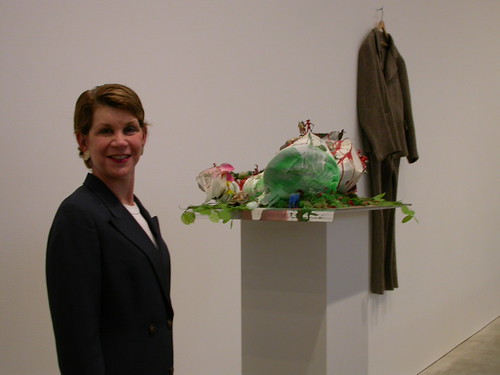
Mari Shaw posing with one of her Isa Genzken works at the PMA last April.
I met Mari Shaw briefly at the Philadelphia Museum of Art last April when Libby and I visited the first Notations installation before it opened. Shaw was there with PMA Curator of Contemporary Art Carlos Basualdo checking out her Isa Genzken piece which was on loan to the PMA for the show. “She’s a very good friend and I admire very much what she and Peter are doing,” says Basualdo. Basualdo especially likes how the Shaws weave together international artists and local artists in their collection. It’s their particular strong suit as collectors. “I’ve met Philadelphia artists at their house. They’re always bringing people together. It’s super nice,” he says.
Libby told you about Candida Hofer’s talk at Slought Foundation in September. Here’s my review of the recent Hofer exhibit at Sonnabend Gallery. And now, since Shaw is a big, although under-the-radar part of the art scene in Philadelphia, I’ll tell you about her.
Salad and mineral water
In several meetings in her kitchen over lunch of salad and mineral water, Shaw, youthful, slim and companionable, told me of her love of art, and her fascination with originality and creativity. The story rambled every which way and included bits about Philadelphia (she’s very, very, very excited about Michael Nutter being mayor because he’s going to support culture) and bits about Berlin where she and her husband spend time each year going to museums and the theatre and making connections in the art world they are players in.
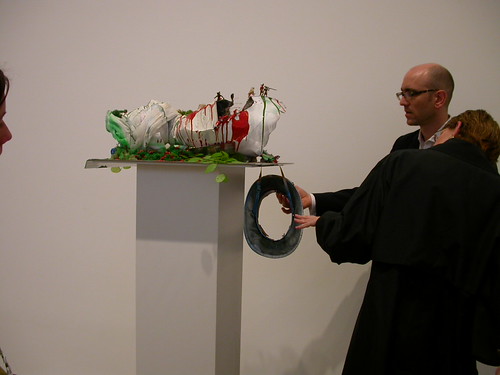
Shaw and Curator of Contemporary Art, Carlos Basualdo, discussing the placement of the Isa Genzken piece in the PMA.
Her own story begins in Chicago, where she grew up. She had an uncle who lived nearby and he was a painter. When Shaw was six or seven, the uncle painted her picture. “He captured the determination in my eyes,” she said. She was close to him and they talked a lot. As soon as she could, Shaw started taking the train to the museum to look at art.
College years were spent in Illinois where she got a bachelor’s degree from University of Illinois (summa cum laude; Phi Beta Kappa), and in Wisconsin where she got a law degree at the University of Wisconsin (JD 1972, first in her class).
She married and had her first child, and became step-mother to two children from her second marriage, to Peter Shaw. Then, after practicing law at a high level for many years and bringing the stress of the job home with her, she decided she’d had enough. She retired from the law, although she still consults. But now her time is devoted to taking classes at University of Pennsylvania, teaching a class on originality there and reaching out to bring international artists to Philadelphia – and, she hopes, to bring Philadelphia artists to Berlin.
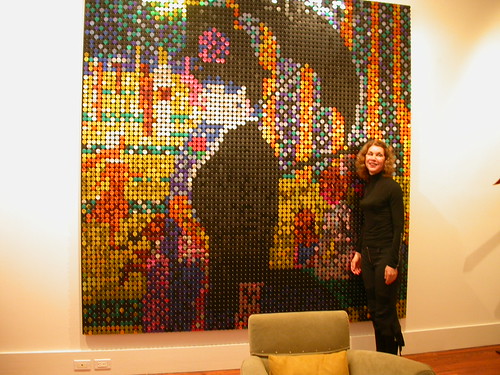
Shaw, standing in front of a Stuart Netsky piece, a re-interpretation of Seurat’s Island of Grande Jatte.
Some collectors don’t want to meet the artists. They don’t want to talk with the artists –they just want to own the art. Shaw likes nothing more than to talk with artists. “From the time I had my son 35 years ago,” Shaw said, “Watching him grow up and how his mind worked” she’s been on a quest to understand the process of creation. That fascination is what makes her want to be around artists. She’s been helping Vasco Araujo, the Portuguese artist she brought here for a residency at Uarts with a project at Independence Mall involving volunteers at the site of George Washington’s house (which will be a museum that will deal with Washington’s relationship with his slaves). She can’t go at the same time that Vasco is there, she said, or they wouldn’t get work done because they’d be talking with each other too much.
This ends part one. Read part 2 about Mari Shaw.


